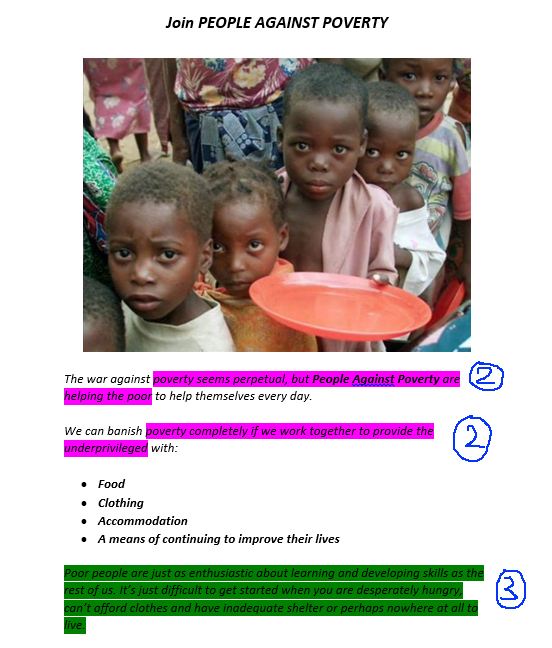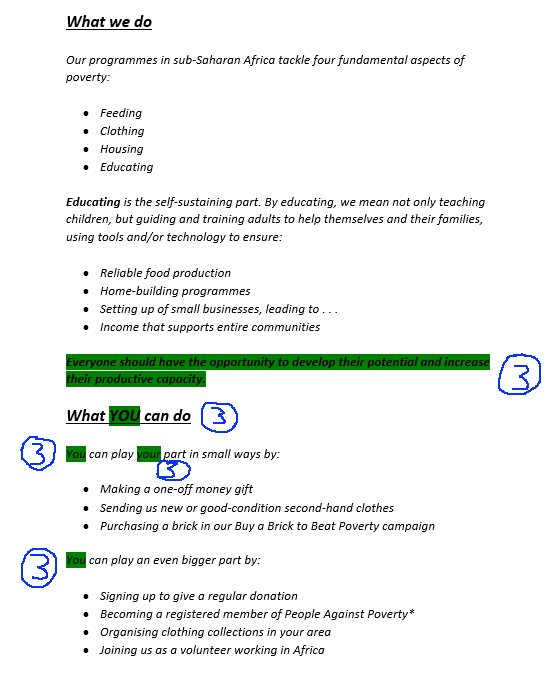Answering the question
Remember, the question will be something like:
“How does the writer use language features for effect?
Remember to:
- Give some examples of language features
- Explain the effects”
1. Write down the four language feature (PSPS) headings:
- Pretending
- Sound
- Persuasion
- Speech
2. Highlight each of the headings in a different colour, e.g.:

3. Now write down the four effects headings, numbering them 1 to 4:
- Understand
- Sense
- Respond
- Remember
4. Now read through the source text and highlight every language feature you encounter as you go in the highlight colour you’ve given it.
5. Consider the effect that each highlighted language feature has on you and write down the number of the effect heading (from step 3 above) next to the appropriate highlighted text.
The source text should now look something like this:



This time, nearly all of the highlights are green (for Persuasion), showing that the writer’s overriding intention is to persuade you to do something – in this case, help a charity called People Against Poverty.
6. Now, write down your answer, dealing with each of the language features in turn, giving examples (quotes from the text) and explaining the effects:
(As before, text in red is for your guidance only and would not be included in your answer.)
Brief introduction
The writer of this example of direct mail is trying to persuade people to support a charity with money and actions. There are so many charities competing for the public’s attention that letters of this kind must contain features that are very persuasive. There are many such features in this example.
Language feature: Sound – alliteration
At the start of the text, the writer uses alliteration while making a couple of major points about the charity’s aims. “The war against poverty seems perpetual, but People Against Poverty are helping the poor to help themselves every day” repeats the “P” sound many times.
Effect: An introduction that sounds pleasing helps get the reader into the letter
Even when read silently, the alliteration makes the text “sound” more inviting. The reader will be more likely to continue reading.
Language feature: Sound – alliteration and consonance
The next line continues the alliterative theme of the first, with more play on the “P” sound (the words poverty, completely, provide and underprivileged) to complement the bold claim that “we can banish poverty completely” if only we can work together to provide certain basics.
Effect: More pleasing sounds to charm the reader
Pleasing sound effects like alliteration make statements like this more memorable and encourage the reader to stay with the text.
Language feature: Persuasion – empathy and pathos
The writer uses empathy and pathos to persuade the reader that poverty is the only barrier to poor people being able to learn and develop skills. We can easily empathise with the view that “Poor people are just as enthusiastic about learning and developing skills as the rest of us. It’s just difficult to get started when you are desperately hungry, can’t afford clothes and have inadequate shelter or perhaps nowhere at all to live.” The second sentence here conveys the sadness and the pathos associated with the helplessness poverty brings.
Effect: Response – makes us feel we ought to help
This will make many readers feel that they should help.
Language feature: Persuasion
The statement: “Everyone should have the opportunity to develop their potential and increase their productive capacity” is something we can readily agree with and, hopefully, help to achieve.
Effect: makes us empathise with the poor people’s predicament
This makes the reader feel that they are completely on their side, and empathise very strongly with their desire to work their way out of poverty.
Language feature: Persuasion – use of personal pronouns
The writer uses “you” many times, as if addressing the reader personally.
Effect: Response – we are part of the solution
Readers are likely to respond by feeling that they are already part of this movement to provide poor people with the means of helping themselves. Examples include “What you can do”, “You can play your part”, “The difference you can make” and “The difference people just like you have made so far…”
Language feature: Persuasion – spelling out benefits, again using personal pronouns
The writer wants to persuade people to sign up to People Against Poverty as members, and spells out the rewards: “Becoming a member means you get regular updates on our programmes via email and a newsletter. You also get direct messages from some of the people we are helping, so you can see the difference you are making to their lives.” This again includes the use of the personal pronouns, “you” – three times in this case. “You” is a very effective word when it comes to persuasion.
Effect: Respond
This makes readers more likely to respond positively to the invitation to become a member.
Language feature: persuasion – pathos
Abdalla begins his personal story with the words: “MY FAMILY AND I WERE STARVING. OUR HOME, A SMALL WOODEN SHED, HAD BEEN DESTROYED BY FIRE. FOR MONTHS, WE WERE DESPERATE FOR HELP. TWO OF MY CHILDREN WERE NEAR DEATH.”
Effect: Respond
The pathos in these four sentences will evoke sadness, pity and compassion in readers, making it more likely that they will join People Against Poverty and/or help in the other ways.
Language feature: persuasion - expression of thanks
Abdalla’s expression of gratitude at the end of his story – “WE SEND OUR HEARTFELT THANKS TO EVERYONE IN THE UK WHO HAS HELPED IN ANY WAY, LARGE OR SMALL” – shows that there is acknowledgement from the recipients themselves of the help given.
Effect: Response - reader feels assured that the charity’s work is worthwhile
This will make the reader feel that this is a worthwhile programme, providing aid that appears to be warmly appreciated.
Language feature: Persuasion – use of imperatives
Use of imperatives, i.e. “Just do it now!” and “call us now”, is likely to push some readers into action following all the other techniques designed to create empathy, compassion and a clear recognition that helping poor people to help themselves is the way forward.
Effect: Response
The imperatives may induce readers to act by clicking a link.
Language feature: Persuasion – use of personal pronouns “you” and “we”
The writer’s parting shot is a powerful catch-all, reminding the reader that no amount of help is too small, but the greater the help, the quicker the job will be done. The statement: “And remember: NO GIFT IS TOO SMALL, BUT THE MORE YOU CAN DO, THE QUICKER WE BEAT PROVERTY IN AFRICA” also makes use of the personal pronouns “you” and “we”.
Effect: Response
This suggests the reader can be involved in a collaborative effort, working with the charity to bring much-needed relief and a better future for poor people. The reader will be more likely to respond positively.




